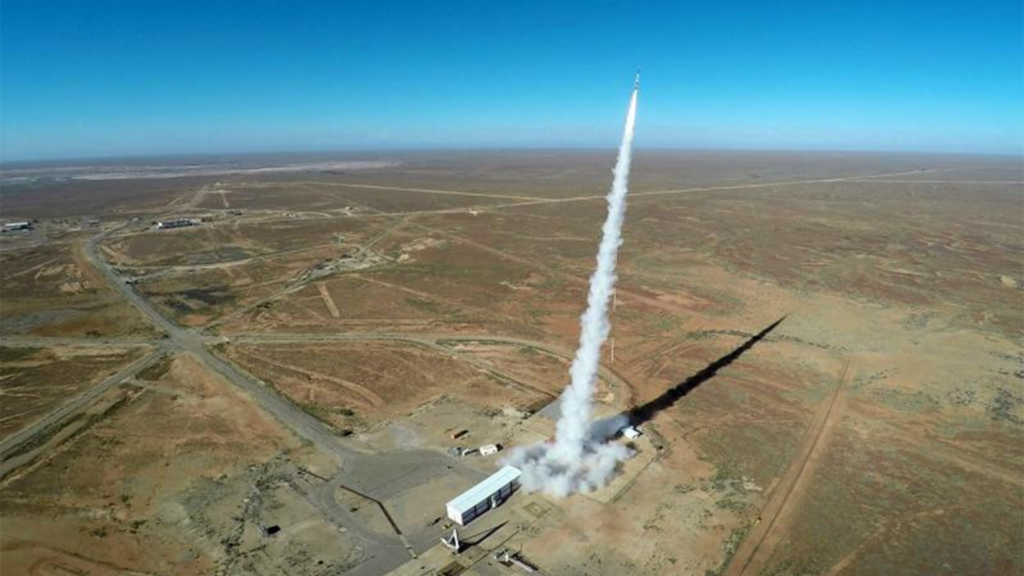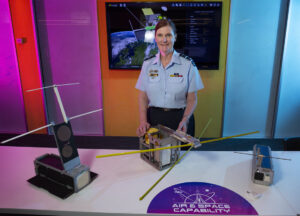
Launch from Woomera, Australia. (Credit Australian Defense Ministry)
SYDNEY: Australian Defense Minister Peter Dutton today announced the formal creation of the country’s Defense Space Command, the formal launch of a new Space Strategy, and millions of dollars of investment in an aging military base — the next wave in a flurry of announcements from the incumbent Liberal party as it gets closer to election day.
Dutton made the announcement at the Royal Australian Air Force’s Air Force and Space Power Conference in Canberra. “It works in close collaboration with the [civilian] Australian Space Agency, industry partners, and our research and scientific institutions,“ Dutton said.
He said the new command will draw from all three services and include civilians and contractors. It will be tiny, initially, with about 100 people. (That small number will do little to assuage industry sources here, who, while eager to see the Australian space business expand, worry that the country will find it difficult to build a large enough space cadre at speed.)
Though unlikely to make the headlines, Dutton said something key for Australia’s global ambitions: “Importantly, Defence Space Command is Australia’s contribution towards a larger, collective effort among like-minded countries to ensure a safe, stable and secure space domain.”
RELATED: JP 9102: Australia opens bidding on its biggest space contract ever
That matters because Australia, long one of the Five Eyes countries that share and use the most sensitive intelligence with the US, Canada, UK and New Zealand, has apparently been granted even closer access to US intelligence, namely with the builder and operator of America’s spy satellites, the National Reconnaissance Office.
“The Australian Department of Defense and the US National Reconnaissance Office have committed to a broad range of cooperative satellite activities which will expand Australia’s space knowledge and capabilities,” Dutton said in his speech at the conference.
“Our partnership will also contribute to the US National Reconnaissance Office’s pursuit of a more capable, integrated, and resilient space architecture to support global coverage in a wide range of intelligence mission requirements.”
This sounds as if Australia will now design its space architecture in cooperation with the NRO, which would seem to indicate that the NRO will share with Australia detailed information about both its existing assets and its future plans.
It had previously been announced that the first head of Space Command will be Air Vice Marshal Cath Roberts, known for her acquisition prowess as demonstrated in getting the Loyal Wingman program going, and for being a forthright and effective leader.

Vice-Marshal Cath Roberts AM, CSC with a model of the M2 CubeSat. Credit: SGT Oliver Carter, Defence.
“I am so happy to be launched!” Roberts told reporters at the conference in Canberra. “it’s been a long time coming.”
In terms of the broader strategic view of her command, Roberts said “I think it’s really important that we start contributing. We’ve got a couple of little satellites up there, but space domain awareness is where we can start and we need to operationalize it because we are so far behind.”
She and Dutton both pointed to aggressive space actions taken by Russia and China in recent years. She said they “scare me. I think that our lack of capability at the moment against those threats, that is concerning. But I have a great ally,” in an obvious reference to the United States, especially since she was sitting with the head of US Space Command, Gen. James Dickinson.
“And it really takes the allies and partners around the world to provide their capabilities to that architecture, and Australia has great geography for that when you look at how big it is and where it is in the world, in the southern hemisphere, and what those capabilities can bring to bear in terms of providing space domain awareness to us,” Dickinson said.
New Strategy, Few Details
The new Space Strategy, in keeping with this government’s tendency to say as little as possible about defense in public, includes five “lines of effort to
-
Enhance Defence’s space capability to assure Joint Force access in a congested and contested space environment
-
Deliver military effects integrated across Whole of Government and with allies and partners in support of Australia’s national security
-
Increase the national understanding of the criticality of space
-
Advance Australia’s sovereign space capability to support the development of a sustainable national space enterprise
-
Evolve the Defence Space Enterprise to ensure a coherent, efficient and effective use of the space domain.”
The strategy is aimed at the next five years, the terse release says.
On top of all that, the government announced yesterday almost a quarter of a billion dollars for “a major upgrade” to a remote base in the northwest.
Curtin, as the base is known, is one of three so-called “bare bases” scattered across the northern reaches of the country. Originally, they were designed to support exercises and to be used in time of national emergency or war.
This is the only one of the three bases to be slated for improvements, so it might be reasonable to conclude it’s being improved because of its location.
“[The project includes] upgrades to communications, water, electrical services, roads, working accommodation, workshops, aircraft hangars, storage areas and security infrastructure,” Melissa Price, minister for defense industry, told the Australian Broadcasting Corporation.
The project is “subject to Government and Parliamentary approval, construction is expected to start in late 2024 and be finished in mid-2026,” a statement from her office said.
The base happens to be in the backyard of the enormous district represented by Price, who made the Monday announcement.
Western Australia is a key battleground for the Liberal Party, with the incumbent party having been virtually wiped out in state elections, hanging on to only two seats out of 59 in the state. Federal elections must be held by late May.






















